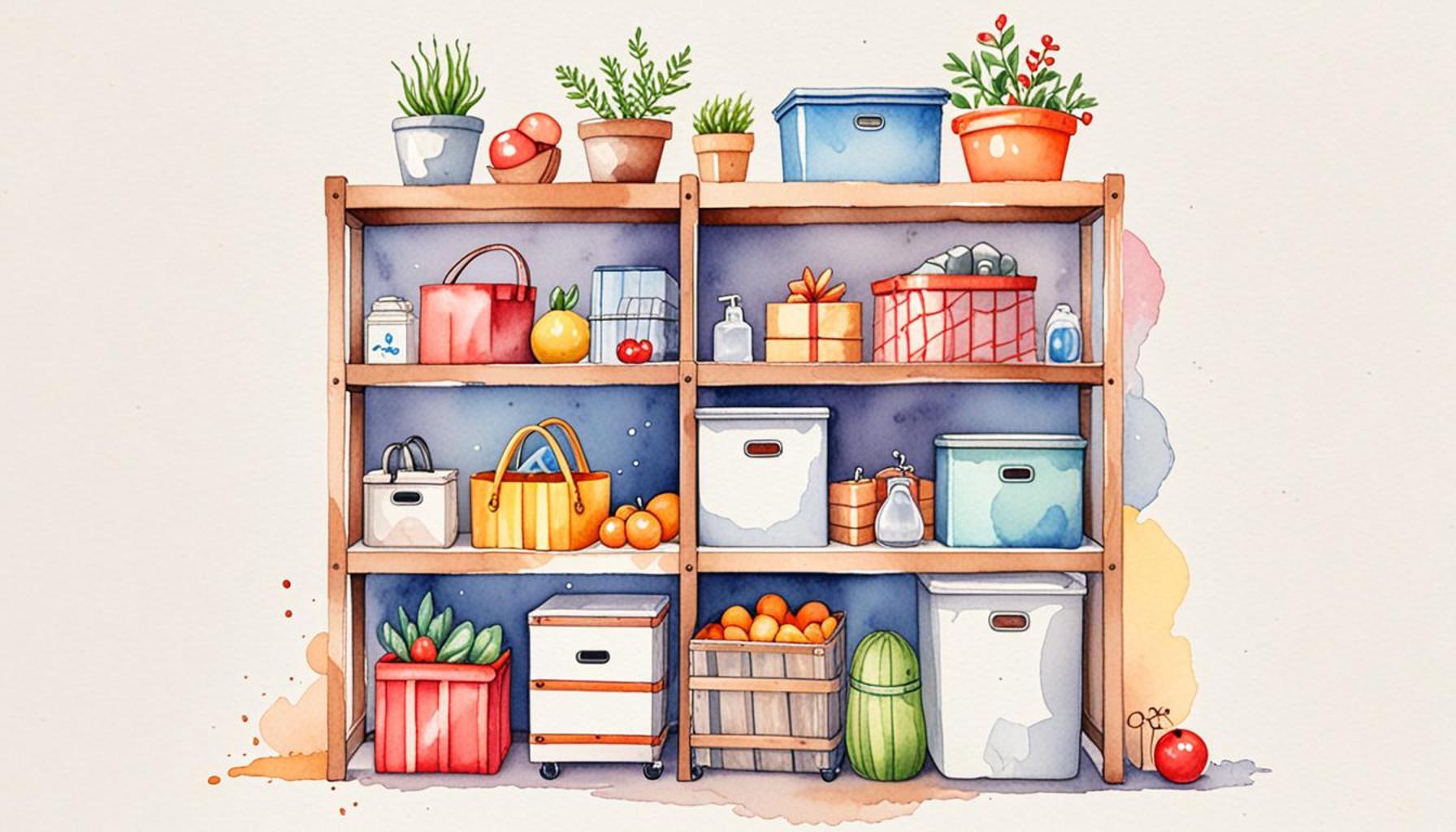Space Optimization Strategies for a Minimalist and Sustainable Life

Exploring the Benefits of Space Optimization
In today’s fast-paced world, where many find themselves surrounded by possessions accumulated over years, the call for a minimalist lifestyle is becoming increasingly significant. Space optimization strategies can lead to profound changes in both physical environments and personal well-being. By decluttering and rearranging our spaces, we can create environments that promote focus, peace, and clarity, ultimately shaping our lifestyle choices.
Why should you consider space optimization? The advantages are numerous and impactful. First, a decluttered environment contributes to reduced stress levels. Studies have shown that clutter can overwhelm the mind, making it difficult to concentrate. A well-organized home can help alleviate anxiety and enhance mental clarity. Additionally, space optimization leads to an increased functionality of living spaces. For example, a small apartment can feel expansive with the right furniture arrangements and organizational methods, allowing residents to maximize every square foot. Finally, these strategies support eco-friendly practices by minimizing waste. When assessing what to keep or discard, individuals often make more sustainable choices, reducing their overall consumption.
Achieving a minimalist lifestyle extends beyond simply getting rid of items; it is also about being intentional with the possessions you choose to retain. Here are some effective strategies to consider:
- Utilizing vertical space: Incorporating shelves, wall hooks, and tall storage units can take advantage of otherwise unused areas. For instance, a wall-mounted shelf in a kitchen can hold spices or cookbooks, freeing up counter space.
- Adopting multi-purpose furniture: Pieces such as sofa beds or ottomans with hidden storage can help streamline spaces. In urban settings like New York City, where living spaces are often limited, such furniture allows for versatility and maximization of usable space.
- Implementing organization systems: Strategies like color-coding, labeling, or using clear bins can promote easy access and efficient use of space. This is particularly important in common areas that serve multiple functions, such as a living room doubling as a workspace.
As you undertake your journey toward a more organized living space, reflect on how your choices can mirror your values. Mindful decisions, whether regarding decor or storage solutions, can enhance not only your personal well-being but the health of our planet as well. By opting for sustainable materials and supporting local artisans, homeowners can turn their spaces into true sanctuaries that offer comfort, functionality, and a commitment to eco-friendliness.
Ultimately, space optimization is more than a mere trend; it is a lifestyle movement encouraging individuals to curate their surroundings thoughtfully. Begin experimenting with these strategies today and uncover the transformative power of embracing a minimalist approach.

DISCOVER MORE: Click here to learn how saying no can boost your productivity
Practical Approaches to Space Optimization
When diving into the realm of space optimization strategies, one quickly realizes that the practices extend far beyond simple decluttering. It involves a deep understanding of one’s environment, a respect for functionality, and a desire to cultivate spaces that are not only aesthetically pleasing but also conducive to a minimalist and sustainable lifestyle. By prioritizing intention in every aspect of our living spaces, we can achieve remarkable transformations.
To get started, it’s essential to assess your current environment and identify areas that can benefit from optimization. Here are some practical approaches that form the cornerstone of effective space management:
- Creating defined zones: Establishing specific areas for different activities—such as work, relaxation, or exercise—ensures that each space serves its purpose without overlap. For instance, a corner of your living room can transform into a dedicated workspace with the addition of a small desk and effective lighting.
- Decluttering regularly: Implement a routine decluttering practice to keep belongings at bay. Schedule a monthly review of your possessions and consider the one-in-one-out rule; when you bring in a new item, consider letting go of another. This allows for sustained minimalism and prevents the accumulation of unnecessary items.
- Incorporating natural elements: Plants can enhance any space while promoting a sense of tranquility. By selecting low-maintenance plant varieties, you can easily add life to an area without overwhelming your space. Not only do plants purify the air, but they can also act as natural decor that requires minimal upkeep.
As you evaluate your living space, embrace the idea that less can indeed be more. An important aspect of successful space optimization involves recognizing the significance of quality over quantity. This philosophy not only reinforces the minimalist mindset but also encourages responsible consumerism. By choosing fewer but higher-quality items, you not only elevate your everyday experience but also contribute positively to the environment.
Consider investing in sustainable materials for furniture and decor. For example, bamboo and reclaimed wood are excellent choices due to their durability and low environmental impact. By selecting products that align with your values, you can reflect a commitment to sustainability while also enhancing your space’s functionality.
Moreover, the integration of technology can further streamline your optimization efforts. Take advantage of innovative organizational apps and smart home systems designed to help you manage your space efficiently. By utilizing technology sensibly, individuals can automate their routines, allowing more time to engage in activities that promote well-being and fulfillment.
As you embark on your journey towards a more organized and harmonious living environment, remember that space optimization is personal. Tailor these strategies to align with your unique lifestyle and values, and watch as your home morphs into a sanctuary that fosters both simplicity and sustainability.
| Category | Benefits |
|---|---|
| Decluttering | Enhances mental clarity and space efficiency by reducing visual distractions. |
| Multifunctional Spaces | Maximizes utility and functionality, allowing for flexible living arrangements. |
| Minimalist Design | Promotes eco-friendliness, utilizing fewer resources and materials for a smaller carbon footprint. |
| Sustainable Materials | Supports a healthier environment by reducing harmful emissions and chemicals in home products. |
In exploring space optimization strategies, a significant trend is the incorporation of decluttering into daily routines. This practice not only creates a more organized environment but also boosts productivity and well-being. Engaging with less clutter helps individuals maintain focus on essential tasks, which is particularly valuable in our fast-paced society. Additionally, embracing multifunctional spaces allows for adaptability in homes, transforming a single area into various functional settings catering to work, leisure, or communal meetings. This approach speaks volumes in urban settings where living space is often at a premium.Moreover, minimalist design plays a pivotal role in advocating sustainability, as it encourages individuals to make intentional choices about their possessions, fostering a culture of thoughtful consumption. Transitioning to sustainable materials—such as reclaimed wood and organic textiles—further enhances this ethos by promoting responsible manufacturing and consumption patterns, essential for preserving our planet for future generations. Implementing these strategies lays the groundwork for a coherent path towards a minimalist and sustainable lifestyle that aligns with contemporary ecological challenges.
DIVE DEEPER: Click here to unlock the secrets of effective delegation
Innovative Solutions for Enhanced Space Efficiency
Beyond the fundamental strategies already discussed, there are several innovative solutions that can significantly enhance space efficiency and contribute to a minimalist and sustainable lifestyle. By embracing creativity and tapping into modern design principles, individuals can optimize their environments in ways that reflect both functionality and eco-friendliness.
One effective approach is the use of multifunctional furniture. This type of furniture serves more than one purpose, thereby reducing the need for excess items. Take, for instance, a sofa bed that offers both seating and sleeping arrangements; or a coffee table that can double as a storage unit. These versatile pieces not only save space but also minimize waste, aligning perfectly with sustainable living practices. Retailers across the United States, such as IKEA, are leading the charge by offering various multifunctional designs that cater to a wide range of tastes and needs.
In addition, consider embracing vertical storage solutions. Utilizing wall space for shelves and hooks can free up valuable floor space and transform cluttered rooms into organized havens. Vertical garden systems, for example, not only optimize space but also create an aesthetic appeal while promoting a sustainable lifestyle. By growing herbs and small plants on walls, one can save ground space and bring a refreshing natural element indoors.
Another innovative strategy is to harness the power of minimalist living apps that promote organization and accountability. Platforms such as “Trello” and “Unclutter” provide organization tools that help users streamline tasks and manage belongings effectively. These apps come equipped with features that allow individuals to create checklists, categorize items, and even set reminders for decluttering sessions. Integrating technology into the minimalist approach not only enhances personal productivity but serves to reinforce goals towards sustainability.
Moreover, smart home technology can also play a significant role in creating sustainable, efficient living spaces. Smart thermostats, for instance, optimize heat management while conserving energy, leading to reduced utility bills and a smaller carbon footprint. By equipping homes with such technologies, residents can enjoy comfort without compromising their commitment to sustainability.
Consider also the rise of tiny living. The tiny house movement promotes the notion of living with just the essentials in beautifully designed, compact spaces. Tiny homes typically range from 100 to 400 square feet, forcing inhabitants to carefully curate their possessions and reflect on what is truly necessary in their lives. This lifestyle exemplifies space optimization and resonates deeply with the principles of minimalism and sustainability.
Lastly, more communities and organizations began to advocate for co-housing models as a sustainable way to live more lightly on the planet. These setups allow individuals to share space and resources, reducing overall consumption and encouraging stronger community ties. Such arrangements not only optimize space efficiency but also promote collaboration and sustainability among neighbors.
As one explores these innovative solutions for space optimization, acquiring a mindset that embraces flexibility and creativity becomes crucial. By challenging conventional living standards, it is possible to cultivate an environment that embodies minimalist and sustainable principles—showing that thoughtful design and sustainability can beautifully coexist in our daily lives.
DISCOVER MORE: Click here to enhance your productivity
Conclusion: Embracing Space Optimization for a Better Future
In summary, the quest for a minimalist and sustainable life is not merely about reducing clutter; it encapsulates the larger aspiration of living harmoniously with both our personal environment and the planet. By implementing space optimization strategies such as multifunctional furniture, vertical storage solutions, and smart home technologies, individuals can create living spaces that are not only more efficient but also embody the values of sustainability and creativity.
The rise of tiny living further illustrates this shift, challenging conventional housing norms and encouraging a lifestyle focused on essentials. Co-housing initiatives signify a growing awareness of communal living as a pathway to optimize resources while fostering deeper connections with neighbors. As communities embrace these models, they create supportive networks that promote a lighter ecological footprint.
Moreover, the integration of minimalist living apps serves as a modern ally in this journey, providing tools to regain control over our belongings and maintain our commitment to sustainability. By leveraging technology and innovative design concepts, we can streamline our lives in compelling ways, enhancing both functionality and aesthetic appeal.
As we move forward, it is essential to cultivate a mindset that embraces adaptability and innovation within our spaces. The intersection of design and sustainability offers a rich landscape for exploring new possibilities in how we live and interact with our homes. By adopting these space optimization strategies, we not only craft a more intentional lifestyle but also contribute to a more sustainable future for our communities and generations to come. Together, let us pave the way to a conscious, eco-friendly living that prioritizes both minimalism and sustainability.


